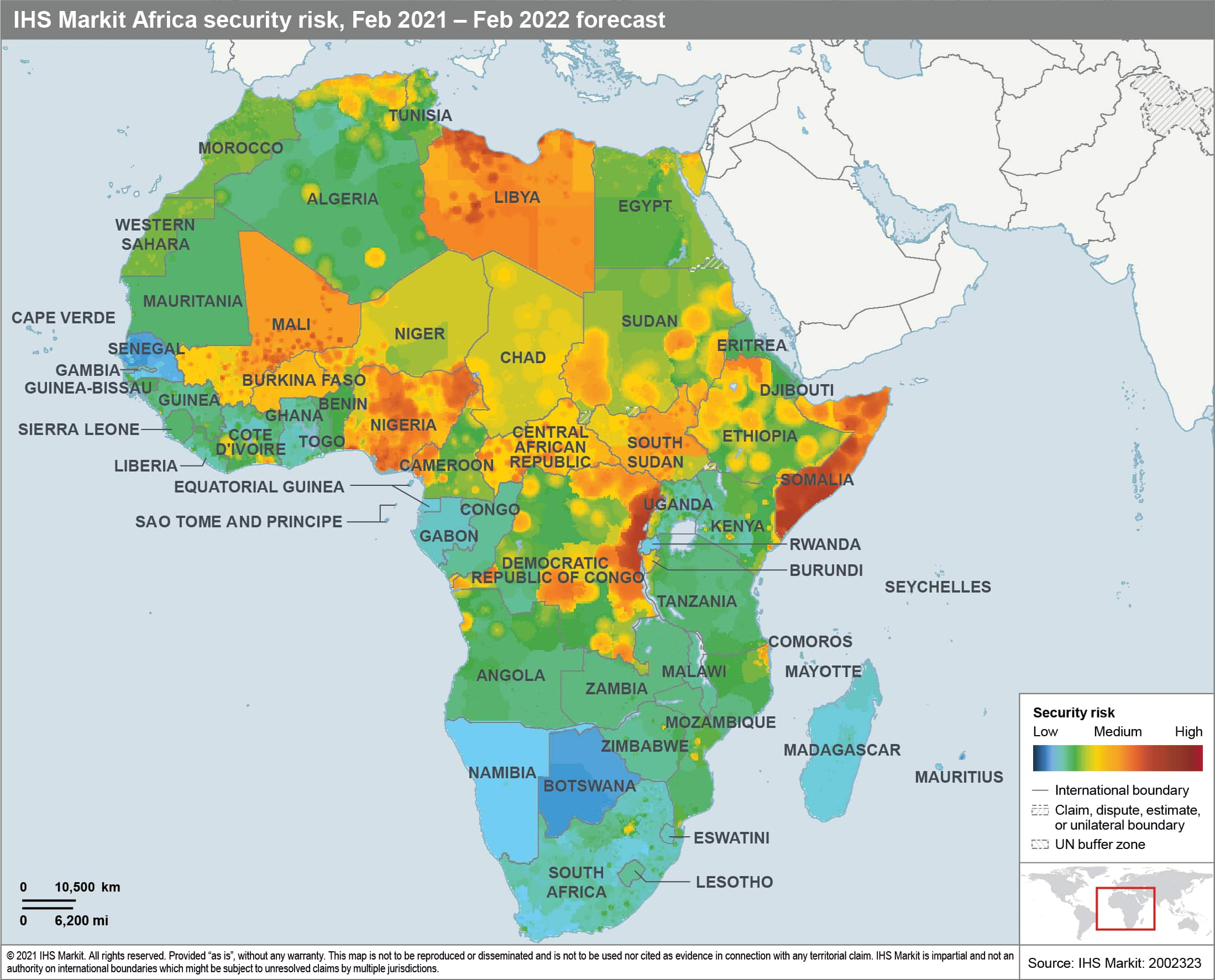The geopolitical implications of vaccine rollout programs across Sub-Saharan Africa
IHS Markit's COVID-19 vulnerability index shows economic disruption to be the most acute impact of the pandemic across sub-Saharan Africa (SSA), with the region recording its first recession in over two decades. Although the number of cases and deaths is highly likely to be under-reported, the region has been spared the heaviest burden of COVID-19 infections and deaths. Excess mortality is very low across the region, likely owing in part to its young population, demonstrated in the index as demographic risk. While several countries across the region such as Ghana, Rwanda, and South Africa have experienced another wave of infections since late 2020, the resultant containment measures have, in most cases, been eased by governments to avoid highly unpopular restrictions on movement and business activity. More important for most governments is mitigating the impact on livelihoods. A 2020 World Bank report forecasted that the COVID-19 pandemic could reverse years of progress in poverty alleviation, placing up to 40 million more Africans at risk of extreme poverty (living on less than USD1.90 per day). This, coupled with a vaccine rollout expected by the World Health Organization (WHO) to take around three years to achieve herd immunity in the region, means that the resumption of economic activity in the region is unlikely to depend on a successful COVID-19 vaccination program.

Fiscal capacity constraints are likely to create gaps in available funding for vaccine supply, driving dependence on donor support. The African Center for Disease Control (CDC) estimates that it will cost up to USD15 billion to achieve the WHO's herd immunity target of at least 60% of the population. However, many regional countries lack the fiscal capacity to self-finance a full or assisted vaccine rollout due to deep budget deficits and high debt burdens for the next several years. Recognizing the fiscal constraints on many SSA countries, the World Bank aims to have disbursed up USD40 billion in grants and concessional lending between March 2020 and June 2021 to support economic recovery as well as COVID-19 responses - which includes testing, treatment, and vaccinations.
Sub-Saharan Africa's reliance on external vaccine supply to delay rollouts
SSA will be reliant in 2021 on external vaccine supply, particularly pooled procurement schemes, raising delays to rollout expectations. Even if completed on schedule, the sub-Saharan African region's vaccination rollout plans will lag behind rollouts globally, with the WHO estimating that, at best, 30-35% of Africa's 1.3 billion population could be vaccinated in 2021. In addition, the WHO's threshold for herd immunity (at least 60% of the population) is only likely to be achieved at the end of 2023. For vaccine supply, the region will rely most heavily on the COVID-19 Global Vaccine Access Facility (COVAX Facility), led by the Coalition for Epidemic Preparedness Innovations (CEPI), the Vaccine Alliance (Gavi), and the WHO. COVAX has pledged to provide participating countries with vaccines to cover 20% of their populations in 2021, which in Africa will predominantly be used for frontline workers. Vaccine supplies to meet this target have not been secured (see graph), with COVAX basing its supply forecast on existing and expected advanced procurement agreements with manufacturers. Although the supplies will be subsidized, participating countries will be expected to pay upfront costs of between USD1.60 and USD10 per dose, depending on the vaccine.
Concerned with delays for the regional vaccine rollout, the African Union's (AU) African Vaccine Acquisition Task Team (AVATT) launched another pooled procurement scheme, having currently agreed to purchase 670 million doses of the AstraZeneca, Pfizer, and Johnson & Johnson vaccines, with the option to procure 300 million doses of the Sputnik V vaccine.
Infrastructural weakness likely to mean vaccine distribution insufficient for timely rollout
With existing infrastructural weakness across many SSA countries, vaccine distribution is likely to be insufficient for a timely rollout and unevenly focused on densely populated, urban areas. WHO analysis published at the end of November 2020 found that only 49% of African countries had identified priority populations for vaccination and had plans in place to reach them; only 44% had co-ordination structures in place; and only 24% had adequate plans for resources and funding. Additionally, only 17% had data collection and monitoring tools in place and just 12% had "plans to communicate with communities to build trust and drive demand for immunization". Although some countries such as Ghana and Rwanda have deployed drones for wider coverage of COVID-19 testing, and the DRC has piloted high-tech solutions for Ebola vaccine delivery, securing sufficient cold-chain supply and storage infrastructure for vaccine distribution at scale will require more time and considerable financial resources. Limited capacity at medical facilities, including staff, will further impair vaccine rollout efforts, especially to more remote areas across the continent. Even within urban areas, prior to the outbreak, medical staff in several countries, such as Kenya and Zimbabwe, had ongoing strikes over mostly working conditions and pay.




